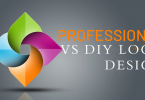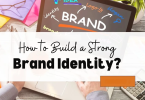When you hear the word “branding,” what comes to mind? Maybe a company’s name, maybe a slogan, but for most people, it’s the logo. It’s the one thing that visually sticks in your mind and instantly connects you with a brand.
That’s exactly why the importance of logo in branding is a topic every business—big or small—should pay close attention to.
Let’s walk through this step by step in a friendly, simple, and honest way—just like having a conversation over coffee.
What is a Logo? More Than Just a Symbol
A logo is a unique graphic mark or symbol that represents a brand. It might be as simple as a wordmark (like Google), a symbol (like Apple), or a combination of both (like Adidas). But don’t let the simplicity fool you.
A great logo is backed by strong thinking, clear branding strategy, and deep emotional insight. It’s not just “art”—it’s a business tool.
Why is a Logo So Important in Branding?

Let’s break down the main reasons why a logo plays such a key role in your brand’s identity.
1. Instant Recognition
Your logo is like your business’s face. When customers see it, they immediately recognize your brand. Think of the golden arches of McDonald’s or the swoosh of Nike—no words needed.
2. Builds Brand Identity
Your logo sets the stage for your entire visual identity. It defines your colors, fonts, tone, and design style. Everything in your branding builds off the logo.
3. Conveys Professionalism
A well-designed logo tells people you’re serious, reliable, and professional. It shows that you’ve put thought into your brand, and that you care about quality.
4. Triggers Emotional Connections
Over time, customers start to associate your logo with emotions—trust, happiness, excitement, etc. It becomes a symbol of their experiences with your brand.
5. Stands Out in the Crowd
The market is full of competition. A unique logo helps you catch attention, look different, and stay in people’s minds.
📊 Roles a Logo Plays in Branding
| Role | Description |
| Recognition | Helps customers easily identify your brand |
| Emotional Bonding | Triggers feelings and memories associated with the brand |
| Brand Storytelling | Can visually communicate your values, mission, or purpose |
| Consistency in Branding | Acts as a visual anchor for all marketing and branding efforts |
| Trust & Professionalism | Builds customer confidence through polished and cohesive visual identity |
✅ Benefits of a Strong Logo in Branding
Here’swhat you gain by investing in a well-thought-out, custom-designed lo
- Confusing Messaging: A mismatched logo can confuse customers about what your business does.
- Lack of Appeal: A generic or outdated logo may fail to grab attention.
- Inconsistency: If your logo doesn’t match the rest of your branding, it weakens your identity
Damaged Trust: A low-quality design may make you seem unprofessional or unreliable
Now let’s talk about the flip side—what happens if your logo doesn’t represent your brand properly?
- Confusing Messaging: A mismatched logo can confuse customers about what your business does.
- Lack of Appeal: A generic or outdated logo may fail to grab attention.
- Inconsistency: If your logo doesn’t match the rest of your branding, it weakens your identity.
- Damaged Trust: A low-quality design may make you seem unprofessional or unreliable.
❌ Drawbacks of a Poor Logo
📊 Benefits vs. Drawbacks

| Benefits of a Good Logo | Drawbacks of a Poor Logo |
| Builds trust and loyalty | Creates confusion and looks unprofessional |
| Boosts recognition and brand recall | Hard to remember or relate to |
| Enhances marketing and brand consistency | Doesn’t reflect brand values or voice |
| Helps stand out from competitors | Gets lost among similar or generic brands |
| Adds value and longevity to the brand | May need frequent redesigns, wasting time & money |
You may also like to read these posts:
https://printcod.com/wp-admin/post.php?post=88&action=edit
https://printcod.com/wp-admin/post.php?post=96&action=edit
https://printcod.com/wp-admin/post.php?post=121&action=edit
https://printcod.com/wp-admin/post.php?post=108&action=edit
🔹 Tips for Creating a Logo that Builds Your Brand
Want your logo to make a strong branding impact? Follow these tips:
1-Understand Your Audience
Know your target customer’s age, interests, and expectations.
2-Use the Right Colors
Colors convey emotions. Blue shows trust, red shows energy, green shows growth, etc.
3-Choose the Right Font
Serif fonts = tradition; Sans-serif fonts = modern; Script fonts = creativity.
4-Test for Versatility
Make sure it looks good in black and white, small sizes, and on all devices.
5-Avoid Overcomplication
Keep it simple. Too many details can make your logo hard to remember.
🔁 Real-Life Example
Imagine you’re launching a bakery. You have delicious products, friendly service, and great prices. But your logo looks like clipart from the 90s. People might assume your products aren’t fresh or that your business isn’t trustworthy—even before they try your food.
On the other hand, if you have a stylish, warm, and modern logo, people feel an instant emotional connection. They’re more likely to stop, explore, and buy.
That’s the power of a good logo.
🔚 Conclusion
So here’s the truth: the importance of logo in branding goes far beyond looks. It’s the foundation of your visual identity, the first thing customers see, and the last thing they remember.
A great logo speaks volumes—it builds trust, evokes emotion, and helps your business grow. If you’re serious about your brand’s future, your logo deserves serious attention.
❓FAQs
Q1: Can I design my own logo as a beginner?
Yes, you can use free tools like Canva or Wix Logo Maker, but be cautious—these logos may not be unique or professional enough for long-term branding.
Q2: What makes a logo timeless?
Simplicity, clarity, and a strong connection to your brand message. Avoid trends that may go out of style quickly.
Q3: How much should I spend on a logo?
Prices vary—from free tools to thousands of dollars. For small businesses, spending a few hundred rupees/dollars on a freelancer or design service is a good middle ground.
Q4: Should a logo include the business name?
Not always. Some logos work well without text (like Apple), but for new brands, combining a symbol and name helps with recognition.
Q5: How do I know if my logo is working?
Ask your audience, look at brand recall, and see how it fits across platforms. A good logo should be versatile, memorable, and aligned with your message.






